Time-Based and Window Operators
info
Stream Processing with Apache Flink 第6章读书笔记 示例代码见flink-example
设置时间语义
Flink应用的时间语义由StreamExecutionEnvironment的属性timeCharacteristic确定,它可以设置如下枚举值:
TimeCharacteristic.ProcessingTime:设置时间语义为处理时间,计算结果快但是不准确,会漏掉延迟数据。
TimeCharacteristic.EventTime:设置时间语义为事件时间,数据自身提供timestamp。Timestamp可以是数据本身的一个字段,也可以在source算子上赋值。计算结果准确,为了处理乱序数据会有延迟。
TimeCharacteristic.IngestionTime:指定source算子的处理时间为事件时间,可以视为ProcessingTime和EventTime的结合体。
通过env.setStreamTimeCharacteristic(TimeCharacteristic.EventTime)
指定timestamp和生成水印
当设置时间语义为事件时间后,需要指定timestamp和生成水印,这里有2种方式实现:
在SourceFunction中设置
调用
assignTimestampsAndWatermarks(TimestampAssigner)方法
根据水印生成离数据源越近越安全的原则,调用assignTimestampsAndWatermarks应该紧跟着source方法之后,位于所有基于事件时间的function之前,最好直接在SourceFunction中生成水印。
TimestampAssigner接口还派生出AssignerWithPeriodicWatermarks和AssignerWithPunctuatedWatermarks,表示不同的生成策略。
周期性水印
周期性水印默认每200ms发送一次水印,通过StreamExecutionEnvironment.getConfig.setAutoWatermarkInterval(int)设置发送间隔,或者实现AssignerWithPeriodicWatermarks接口的getCurrentWatermark方法。DataStream API还提供如下2个快捷项:
如果确认输入数据的时间戳单调递增,使用快捷方法assignAscendingTimeStamps设置timestamp和水印。
如果数据乱序到达,使用BoundedOutOfOrdernessTimeStampExtractor设置timestamp和水印。
间断性水印
间断性水印的生成由输入数据的某些属性确定,AssignerWithPunctuatedWatermarks接口定义了checkAndGetNextWatermark()方法,该方法在每次的extractTimestamp()调用后执行,如下所示代码在id包含"sensor_1"时产生水印:
public class SensorTimeAssigner implements AssignerWithPunctuatedWatermarks<SensorReading> {
@Nullable
@Override
public Watermark checkAndGetNextWatermark(SensorReading lastElement, long extractedTimestamp) {
if("sensor_1".equals(lastElement.id)) {
return new Watermark(extractedTimestamp - 60*1000);
} else {
return null
}
}
@Override
public long extractTimestamp(SensorReading element, long recordTimestamp) {
return element.timestamp;
}
}
注意
AssignerWithPeriodicWatermarks和AssignerWithPunctuatedWatermarks接口已经过时,使用WatermarkStrategy代替。
水印,延迟和完整度
水印用于调整延迟和结果完整度的平衡,即算子在等待多久后触发计算。现实中无法设置完美的水印,因为网络等各种因素影响着结果。水印设置过大,等待时间增加,状态变量增大,但结果更准确。水印设置过小,等待时间缩减但结果不准确。
处理函数
DataStream API提供了比转换函数更底层的处理函数(Process Function),其功能更加丰富,比如可以访问timestamp和水印。Flink提供的处理函数有:
- ProcessFunction
- KeyedProcessFunction
- CoProcessFunction
- ProcessJoinFunction
- BroadcastProcessFunction
- KeyedBroadcastProcessFunction
- ProcessWindowFunction
由于这些接口类似,以KeyedProcessFunction为例介绍,该接口提供如下方法:
processElement(I value, Context ctx, Collector<O> out):处理流上的每个记录value,将结果输出到out。Context对象提供timestamp和TimerService。onTimer(long timestamp, OnTimerContext ctx, Collector<O> out):设置定时器的回调方法。
TimerService和Timer
Context和OnTimerContext都包含TimerService对象,它提供如下方法:
long currentProcessingTime():返回当前处理时间long currentWatermark():返回当前水印void registerProcessingTimeTimer(long time):注册一个处理时间定时器void registerEventTimeTimer(long time):注册一个事件时间定时器void deleteProcessingTimeTimer(long timestamp):删除一个处理时间定时器,如果不存在则什么也不做void deleteEventTimeTimer(long timestamp):删除一个事件时间定时器,如果不存在则什么也不做
定时器触发后执行onTimer()回调,它和processElement()是同步的,避免并发访问状态。定时器会和其他状态一起被检查点保存。
发送到Side Outputs
通常情况下DataStream API中算子只输出单个流,只有split算子输出多个流(且基本类型不变)。但处理函数特殊之处在于它们有侧输出(Side Output),并且基本类型可变,如下所示:
DataStream<SensorReading> monitoredReadings = readings.process(new FreezingMonitor());
// 获取侧输出流并打印
monitorReadings.getSideOutput(new OutputTag<String>("freezing-alarms")).print();
public static class FreezingMonitor extends ProcessFunction<SensorReading, SensorReading> {
OutputTag<String> freezingAlarmOutput = new OutputTag<>("freezing-alarms");
@Override
public void processElement(SensorReading value, Context ctx, Collector<SensorReading> out) throws Exception {
if(value.temperature < 32.0) {
ctx.output(freezingAlarmOutput, "Freezing Alarm for " + value.id);
}
out.collect(value);
}
}
在processElement方法中通过Context.output()发送侧输出数据,侧输出由OutputTag对象标记识别。
CoProcessFunction
对于处理2个流的底层操作,DataStream API提供CoProcessFunction。和CoMapFunction类似,它提供processElement1()和processElement2()两个方法分别处理每个流的输入。
窗口操作
窗口操作使得在无界的流上进行聚合函数计算称为可能,本节介绍如何定义窗口算子、内置窗口类型、窗口可用函数和如何自定义窗口逻辑。
使用窗口算子
KeyedStream或者非KeyedStream都可以使用窗口算子,创建窗口算子需要指定如下两个组件:
Window Assigner:决定元素如何组成窗口,即生成WindowedStream或者AllWindowedStream(在非KeyedStream上)。
Window Function:处理WindowedStream或者AllWindowedStream的元素
如下所示为窗口操作和窗口函数使用的伪代码:
// define a keyed window operator
stream
.keyBy(...)
.window(...) // specify the window assigner
.reduce/aggregate/process(...) // specify the window function
// define a nonkeyed window-all operator
stream
.windowAll(...) // specify the window assigner
.reduce/aggregate/process(...) // specify the window function
内置Window Assigner
Flink内置了许多Window Assigner满足不同使用场景,本节讨论基于时间的窗口操作(基于计数的窗口操作结果不准确)。每个窗口都有一个开始时间和一个结束时间,窗口的范围是左闭右开。以下介绍内置的开窗算子:
- 滚动窗口
滚动窗口分配器将元素分为固定大小,互不重叠的窗口,如下图所示:
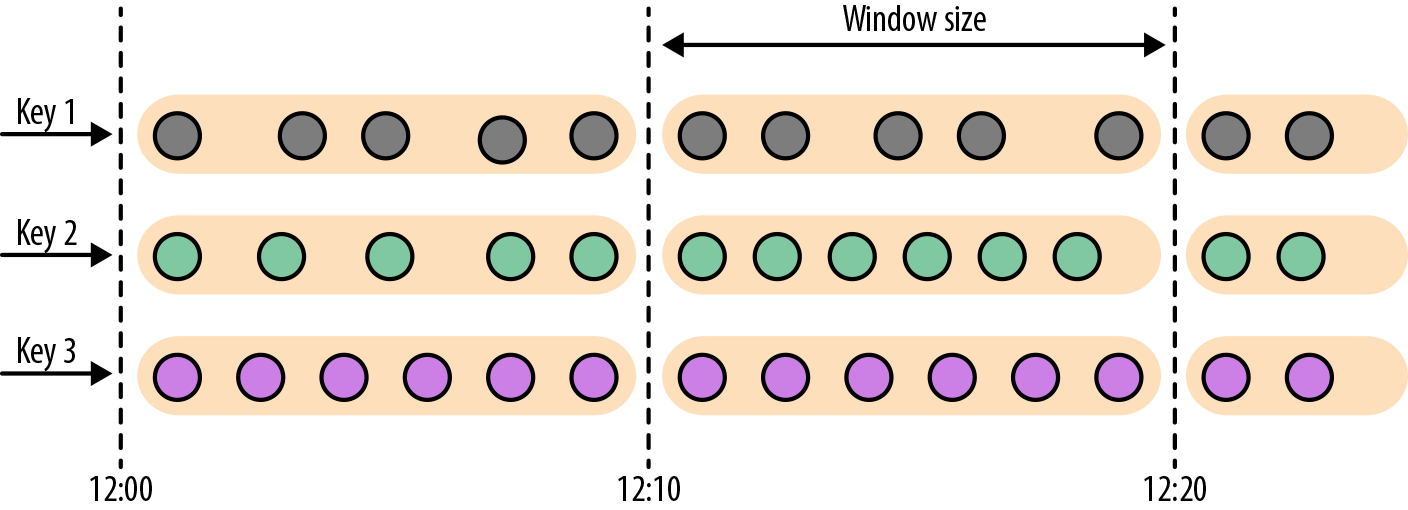
对于事件时间语义和处理时间语义,DataStream API分别提供TumblingEventTimeWindows和TumblingProcessingTimeWindows。使用其静态方法of(Time size, Time offset)指定窗口大小和偏移量,代码如下所示:
sensorData.keyBy(r -> r.id)
// timeWindow(Time.hours(1))已过时,它实际上是下面代码的封装
.window(TumblingEventTimeWindows.of(Time.hours(1), Time.minutes(15)))
.process(new TemperatureAverager());
滚动窗口默认和1970-01-01 00:00:00对齐,以上示例代码定义了[00:15:00-01:15:00),[00:15:00-02:15:00)...窗口。
- 滑动窗口
滑动窗口分配器将元素分为固定大小,偏移指定大小的窗口,如下图所示:
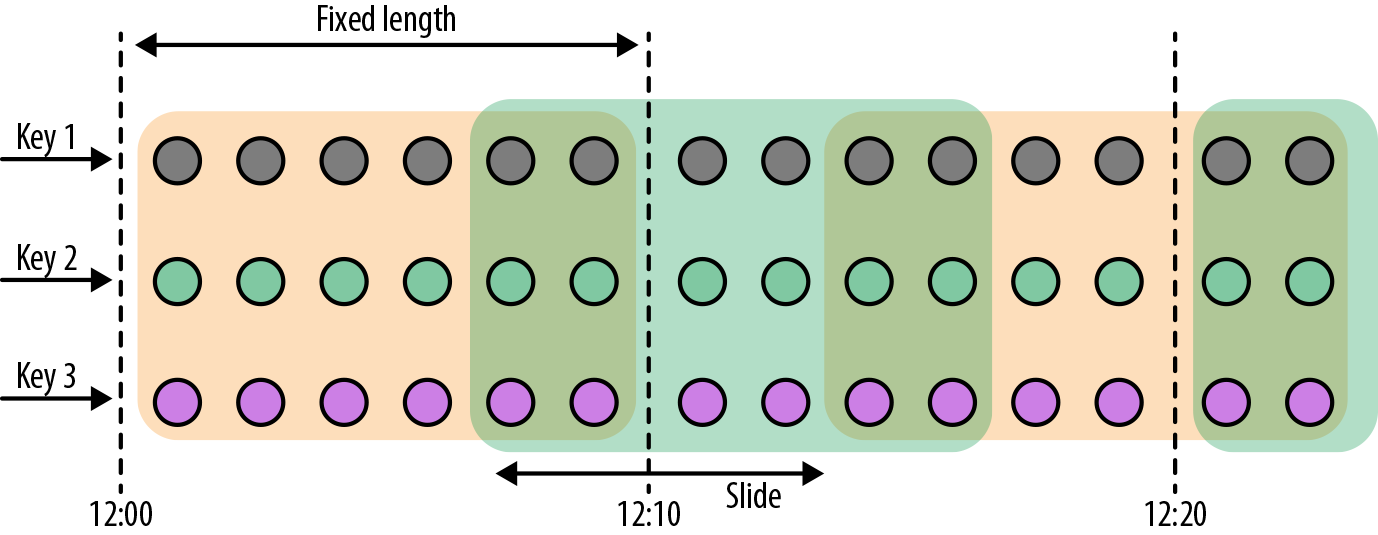
滚动窗口需要指定窗口大小size和滑动步长slide。如果slide小于size,那么会有一些元素属于两个窗口,如果slide大于size,那么会有一些元素没有包含在窗口中。如下代码演示大小为1个小时,步长为15分钟的滑动窗口操作:
sensorData.keyBy(r -> r.id)
.window(SlidingEventTimeWindows.of(Time.hours(1), Time.minutes(15)))
.process(new TemperatureAverager());
- 会话窗口
会话窗口分配器将元素划分为大小不同、互不重叠的窗口,如下图所示,会话窗口的边界由session gap确定:

如下所示代码按照15分钟为gap划分会话窗口。由于分配器不能立即将元素分配到对于会话窗口,它将每个元素划分到以其timestamp为起始时间、大小为gap的独立窗口,然后合并范围重叠的独立窗口。
sensorData.keyBy(_.id)
// create event-time session windows with a 15 min gap
.window(EventTimeSessionWindows.withGap(Time.minutes(15)))
.process(...)
窗口函数
窗口函数对窗口内的元素进行计算,可分为两类:
增量聚合函数:每当新元素添加到窗口时触发,优点是节省空间,例如
ReduceFunction和AggregateFunction。全量窗口函数:窗口所有元素到齐后触发,占用空间多,例如
ProcessWindowFunction。
- ReduceFunction
接收2个相同类型的元素并产生一个相同类型的新元素作为窗口状态,如下示例代码计算每隔15秒的最低温度:
DataStream<Tuple2<String, Double>> minTempPerWindow = sensorData
.map(r -> new Tuple<String, Double>(r.id, r.temperature))
.keyBy(r -> r.f1)
.window(TumblingEventTimeWindows.of(Time.seconds(15)))
.reduce((r1, r2) -> (r1.f1, Math.min(r1.f2, r2.f2)));
- AggregateFunction
AggregateFunction功能和ReduceFunction类似,但输入、输出元素和状态元素的类型可以互不相同,接口定义如下所示:
public interface AggregateFunction<IN, ACC, OUT> extends Function, Serializable {
// create a new accumulator to start a new aggregate.
ACC createAccumulator();
// add an input element to the accumulator and return the accumulator.
ACC add(IN value, ACC accumulator);
// compute the result from the accumulator and return it.
OUT getResult(ACC accumulator);
// merge two accumulators and return the result.
ACC merge(ACC a, ACC b);
}
- ProcessWindowFunction
ReduceFunction和AggregateFunction用于增量式地处理窗口元素,而有些时候需要窗口所有元素到齐后才能处理,比如计算中位数,此时需要ProcessWindowFunction来处理。
public abstract class ProcessWindowFunction<IN, OUT, KEY, W extends Window>
extends AbstractRichFunction {
/** Evaluates the window and outputs none or several elements. */
public abstract void process(
KEY key, Context context, Iterable<IN> elements, Collector<OUT> out) throws Exception;
/** Deletes any state in the Context when the Window expires. */
public void clear(Context context) throws Exception {}
/** The context holding window metadata. */
public abstract class Context implements java.io.Serializable {
/** Returns the window that is being evaluated. */
public abstract W window();
/** Returns the current processing time. */
public abstract long currentProcessingTime();
/** Returns the current event-time watermark. */
public abstract long currentWatermark();
/** State accessor for per-key and per-window state. */
public abstract KeyedStateStore windowState();
/** State accessor for per-key global state. */
public abstract KeyedStateStore globalState();
/** Emits a record to the side output identified by OutputTag. */
public abstract <X> void output(OutputTag<X> outputTag, X value);
}
}
和ProcessFunction类似,ProcessWindowFunction也提供了Context参数扩展函数功能。ProcessWindowFunction的Context对象提供窗口元信息(比如窗口的开始、结束时间),以及窗口状态(Per-window State)和全局状态(Global state)。
全局状态指不属于任何窗口的键控状态,窗口状态指当前窗口示例的状态。使用窗口状态时需要实现clear()方法清除之前的窗口状态,而全局状态用于状态共享。ProcessWindowFunction使用ListState存储状态,因此比ReduceFunction和AggregateFunction消耗更多的内存。
- 增量聚合➕ProcessWindowFunction
如果既想使用增量聚合又想获取窗口元信息,DataStream API提供重载的reduce()和aggregate()方法,将ProcessWindowFunction作为第二个参数传入,此时ProcessWindowFuncton的Iterable参数只有一个元素,即增量聚合后的结果,代码见CalculateMinMaxTemp.java。
自定义窗口算子
当内置窗口算子无法满复杂的应用逻辑时,DataStream API通过暴露接口支持自定义窗口算子。自定义窗口算子分为3个组件:
分配器(Assigner):将新接收的元素分配到对应的窗口,如果窗口不存在则创建。
触发器(Trigger):新元素传递给窗口的同时也会给触发器,由其决定是否计算、清除窗口状态。触发器的行为取决于窗口函数。
- 增量聚合函数立即触发并发送,如下图所示:
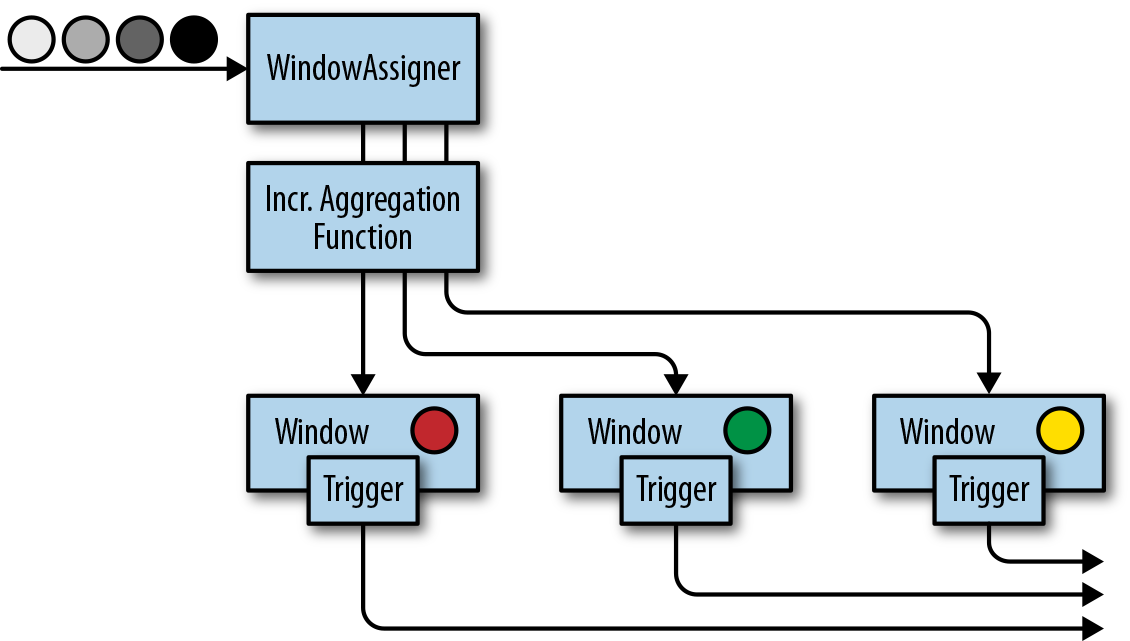
- 全量窗口函数收集所有元素后处理,再发送结果,如下图所示:
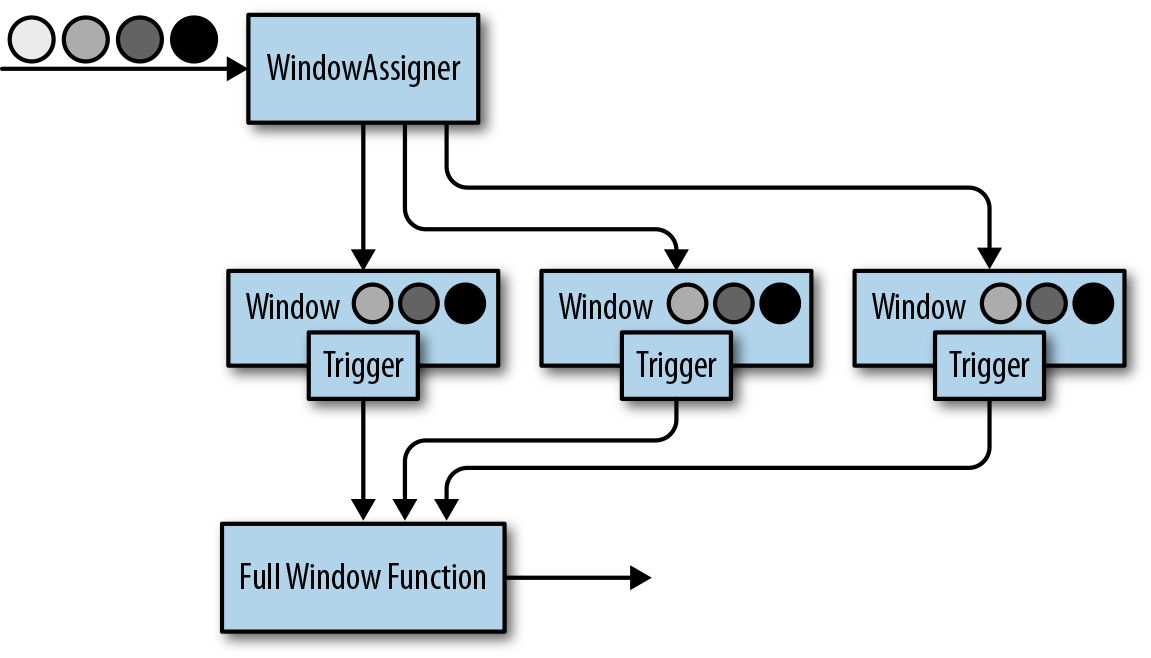
- 增量函数➕聚合函数,等于以上两者的结合体,如下图所示:
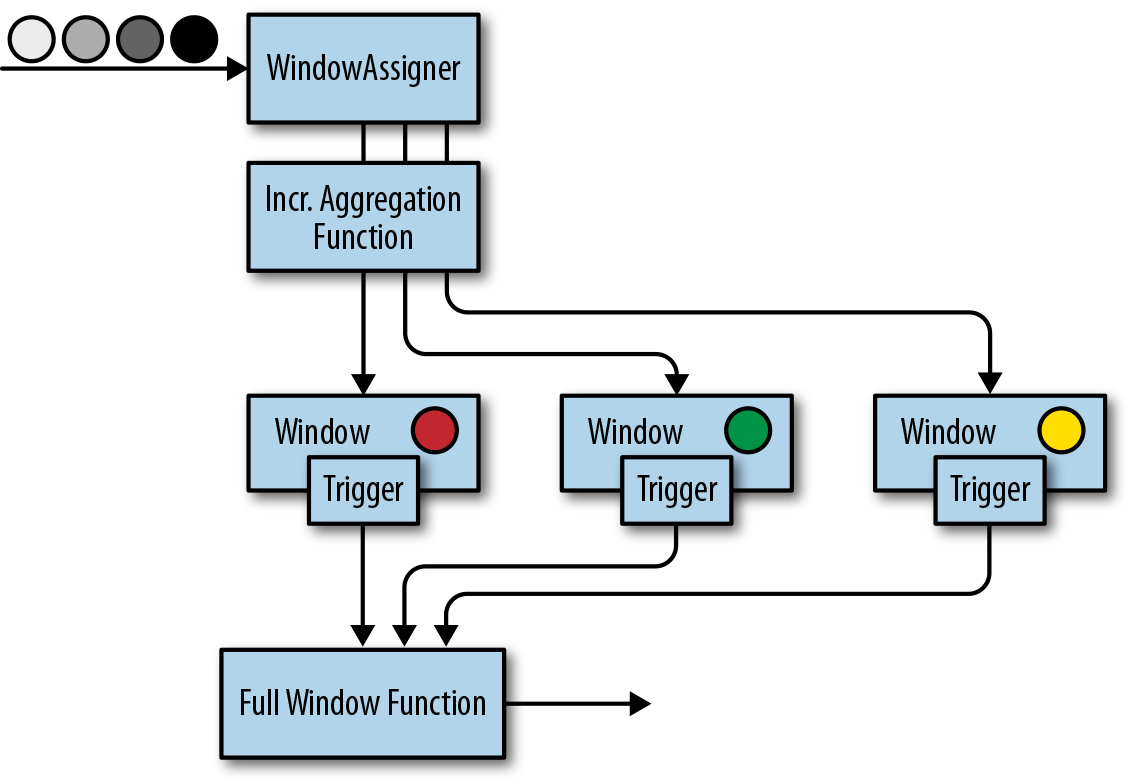
- 增量聚合函数立即触发并发送,如下图所示:
回收器(Evictor):可选组件,可在窗口函数执行前后注入,负责将窗口元素清空,只适用于全量窗口函数。
尽管回收器是可选的,但是每个窗口算子都需要一个触发器,每个WindowAssigner都提供一个默认触发器。注意自定义触发器并不是对默认触发器的功能补充,只有最后自定义的触发器才会生效。
窗口生命周期
一个窗口由WindowAssigner创建,包含如下内容:
- 窗口内容:所有属于窗口的元素或者增量聚合函数的结果
- 窗口对象:WindowAssigner返回0,1或多个窗口对象,每个窗口对象包含各自区分的信息,比如窗口结束时间戳
- 定时器:由触发器注册,用于执行回调,比如清空窗口内容
- 自定义状态:触发器可以定义使用窗口状态,由触发器控制状态而不是窗口算子
当到达结束时间,窗口算子删除窗口内容和窗口对象,但是不会清除自定义状态,需要在Trigger.clear()方法中实现以防止内存泄漏。
- Window Assigner
窗口分配器决定元素属于哪个窗口,WindowAssigner接口定义如下,代码WindowLiftcycle.java#ThirtySecondsWindows演示如何创建大小为30s的滚动窗口。:
public abstract class WindowAssigner<T, W extends Window> implements Serializable {
/**
* Returns a {@code Collection} of windows that should be assigned to the element.
*/
public abstract Collection<W> assignWindows(
T element, long timestamp, WindowAssignerContext context);
/** Returns the default trigger associated with this {@code WindowAssigner}. */
public abstract Trigger<T, W> getDefaultTrigger(StreamExecutionEnvironment env);
/**
* Returns a {@link TypeSerializer} for serializing windows that are assigned by this {@code
* WindowAssigner}.
*/
public abstract TypeSerializer<W> getWindowSerializer(ExecutionConfig executionConfig);
/**
* Returns {@code true} if elements are assigned to windows based on event time, {@code false}
* otherwise.
*/
public abstract boolean isEventTime();
/**
* A context provided to the {@link WindowAssigner} that allows it to query the current
* processing time.
*
* <p>This is provided to the assigner by its containing {@link
* org.apache.flink.streaming.runtime.operators.windowing.WindowOperator}, which, in turn, gets
* it from the containing {@link org.apache.flink.streaming.runtime.tasks.StreamTask}.
*/
public abstract static class WindowAssignerContext {
/** Returns the current processing time. */
public abstract long getCurrentProcessingTime();
}
}
GlobalWindows
GlobalWindows将所有元素分配到一个全局窗口,其默认触发器(NeverTrigger)策略为永不触发,因此需要自定义触发器和回收器。
MergingWindowAssigner继承WindowAssigner,用于合并多个窗口,比如之前提到的会话窗口EventTimeSessionWindows。当合并窗口时,要确保窗口状态和触发器也能恰当地合并。
- 触发器
触发器定义什么时候窗口处理和发送结果,可以由时间或者特定条件(元素个数,包含某个特定元素等)确定。默认情况下,当处理时间或者水印大于窗口的终止时间时,触发器被调用并返回TirggerResult决定窗口的下一步动作,有以下枚举值:
- CONTINUE:不触发处理,跳过。
- FIRE:调用ProcessWindowFunction并发送结果,如果只有增量聚合函数,发送当前聚合结果。不会改变窗口状态。
- PURGE:清空当前窗口所有内容,调用ProcessWindowFunction.clear()方法来清空自定义窗口状态。
- FIRE_AND_PURGE:先执行FIRE操作然后执行PURGE操作。
Trigger提供的API能实现各种复杂的逻辑,比如说可以自定义触发几次计算更新但是不发送结果。在自定义Trigger时需要注意两方面:
- 清空状态:实现clear()方法清除自定义窗口状态,通过TriggerContext删除所有定时器。
- 合并Trigger:canMerge()方法返回触发器是否支持合并,onMerge()方法实现合并逻辑。
代码WindowLiftcycle.java#OneSecondIntervalTrigger创建了一个每隔1s触发一次的Trigger。注意使用了自定义状态firstSeen,需要在clear()方法中删除,同时状态类型为ValueState不可合并,因此该Trigger也不能合并(canMerge方法默认返回false)。
- 回收器
回收器是窗口的可选组件,它在窗口函数执行之前或之后负责清除所有元素,接口定义如下:
public interface Evictor<T, W extends Window> extends Serializable {
/** Optionally evicts elements. Called before windowing function. */
void evictBefore(
Iterable<TimestampedValue<T>> elements,
int size,
W window,
EvictorContext evictorContext);
/** Optionally evicts elements. Called after windowing function. */
void evictAfter(
Iterable<TimestampedValue<T>> elements,
int size,
W window,
EvictorContext evictorContext);
/** A context object that is given to {@link Evictor} methods. */
interface EvictorContext {
/** Returns the current processing time. */
long getCurrentProcessingTime();
/**
* Returns the metric group for this {@link Evictor}. This is the same metric group that
* would be returned from {@link RuntimeContext#getMetricGroup()} in a user function.
*
* <p>You must not call methods that create metric objects (such as {@link
* MetricGroup#counter(int)} multiple times but instead call once and store the metric
* object in a field.
*/
MetricGroup getMetricGroup();
/** Returns the current watermark time. */
long getCurrentWatermark();
}
}
evictBefore()和evictAfter()方法在窗口函数执行前后调用,其中参数elements表示窗口所有元素,size表示元素个数,EvictorContext提供当前处理时间和水印,元素通过Iterator的remove方法删除。回收器经常应用于GlobalWindow来部分清理窗口,而不是完全清理整个窗口。
按时间语义连接流
DataStream API提供2个内置算子:间隔连接(Interval Join)和窗口连接(Window Join),它们根据时间条件连接流。如果这两个内置算子不能满足需求,可以通过实现CoProcessFunction,BroadcastProcessFunction或者KeyedBroadcastProcessFunction接口来自定义。
间隔连接
间隔连接将来自两个流中key相同且时间戳间隔不大于指定值的记录合并为一个流。如下图所示为A和B的间隔连接,当B中元素的时间戳和A中元素的时间戳相比没有早于1个小时也没有晚于15分钟时,合并两个流的元素。间隔连接的语义是对称的,即A中元素相比于B中元素没有早于15分钟也没有晚于1个小时。

间隔连接仅支持事件时间和INNER JOIN语义(没有匹配的元素不会输出),使用伪代码如下所示:
input1.keyBy(...)
.between(<lower-bound>, <upper-bound>)
.process(ProcessJoinFunction)
lower-bound和upper-bound可以任意取值,只要lower-bound小于uppder-bound,例如between(Time.hour(-1), Time.minute(15))。间隔连接需要缓存记录:对于第1条流,所有时间戳大于当前水印(upper-bound)的记录被缓存,对于第2条流,所有时间戳大于当前水印加lower-bound的记录被缓存。
窗口连接
窗口连接基于窗口机制,伪代码如下所示:
input1.join(input2)
.where(...) // 指定input1的key属性
.equalTo(...) // 指定input2的key属性
.window(...) // 指定窗口分配器
[.trigger(...)]
[.evictor(...)]
.apply(...) // 指定JoinFunction
窗口连接机制如下图所示,2个输入流按照key分配到公共窗口(包含两个流的记录),再由JoinFunction处理两个流的交叉积。
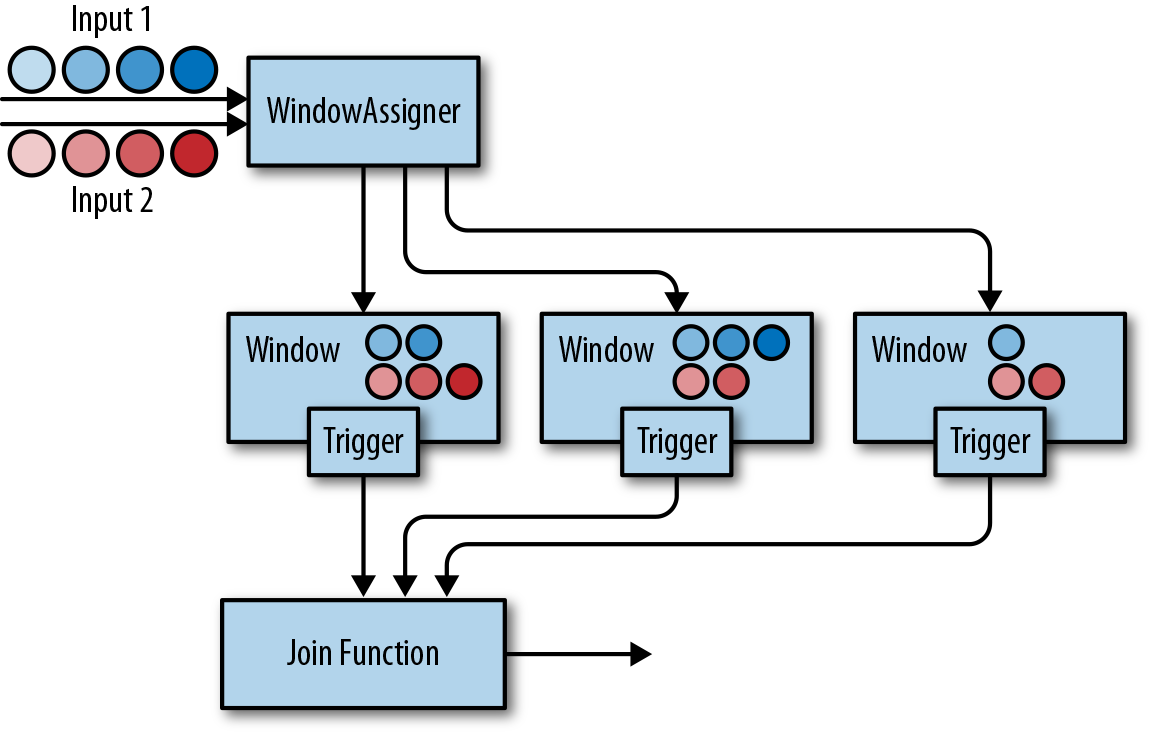
处理延迟数据
DataStream API提供如下策略来处理延迟数据,示例代码见HandleLateData.java:
- 丢弃不管
- 重定向到另一个流
- 用迟延数据再次更新结果并输出
丢弃
最简单的处理策略,是基于事件时间的窗口算子的默认行为。
重定向
将延迟数据重定向到侧输出流,可以使用sideOutputLateData方法或者在ProcessFunction中自行重定向。
更新结果
将延迟的记录重新处理生成更新结果并发送,但需要算子满足特定要求。第一点需要算子保存所有状态,第二点需要下游算子和外部系统支持更新。窗口算子提供allowedLateness()方法设置额外的延迟时间,当水印大于窗口的终止时间后不会删除窗口,而是再等待相应的延迟事件后才删除。也可以在ProcessFunction中实现等待延迟时间的逻辑。
总结
- 时间语义默认为事件时间可以不设置,使用WatermarkStrategy来设置水印和时间戳;
- 处理函数比转换函数功能更加丰富:获取水印,设置/删除定时器,侧输出等;
- 一般使用窗口操作只需要指定分配器和提供窗口函数:内置实现的分配器有滚动、滑动和会话,窗口函数分为增量聚合函数(ReduceFunction、AggregateFunction)和全量窗口函数(ProcessWindowFunction)两类;
- 自定义窗口算子分为3个组件:分配器、触发器和回收器。自定义组件即实现WindowAssigner、Trigger、Evictor这些接口/抽象类;
- 触发器的4种结果:CONTINUE、FIRE、PURGE和FIRE_AND_PURGE影响窗口算子下一步操作。回收器是可选组件,通常用于GlobalWindow;
- 按时间语义连接流的2种方式:间隔连接和窗口连接;
- 处理延迟数据的3种策略:丢弃、重定向和更新结果。重定义可以用sideOutputLateData()或者在ProcessFunction中实现,更新结果需要设置额外延迟事件。